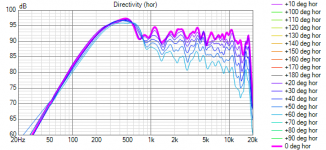Their battery jigsaw is actually pretty good, very low vibrations.I'd trust Makita more if I had their jig saw too
But for speaker building the router is the most important tool ... (have the medium Makita - good enough for what I do)
Curved test baffle has been tested and accepted!
80x1200mm and dipole, but final box can be a bit smaller. I lined the opening with cardboard, installed the coaxial driver, reset eq and xo. SLS-12 drivers haven't arrived yet.
The peak/dip in woofer's response just above 1kHz is still there, but attenuated. In these measurement I set peak correction at 1kHz, 4dB Q3. The CD has 4,7uF serial capacitor. CD has also peak at 5kHz, 2dB Q1. Woofer was lowpassed LR2 at 1600Hz, tweeter runs free with the cap and attenuation -8dB. Woofer delay is 0,28ms. First reflection in measurements at 4,8ms.
Off-axis measurements tomorrow!
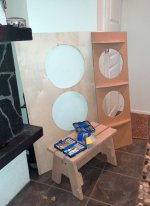
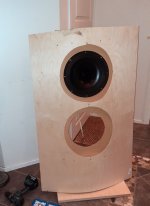
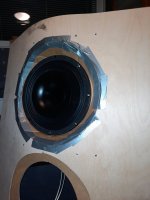
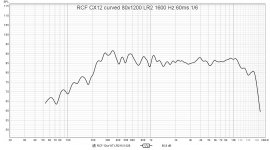
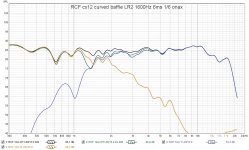
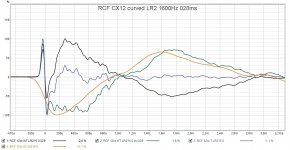
80x1200mm and dipole, but final box can be a bit smaller. I lined the opening with cardboard, installed the coaxial driver, reset eq and xo. SLS-12 drivers haven't arrived yet.
The peak/dip in woofer's response just above 1kHz is still there, but attenuated. In these measurement I set peak correction at 1kHz, 4dB Q3. The CD has 4,7uF serial capacitor. CD has also peak at 5kHz, 2dB Q1. Woofer was lowpassed LR2 at 1600Hz, tweeter runs free with the cap and attenuation -8dB. Woofer delay is 0,28ms. First reflection in measurements at 4,8ms.
Off-axis measurements tomorrow!






Nice progress! I'm convinced you'll be able to tweak this into a really nice response!
Did you change gain settings between the measurements in your step response traces? I can't say for sure, but my guess would be that the woofer could use slightly more delay. It seems the negative peak from the tweeter is reduced with the woofer and tweeter measured together. This makes me think the woofer is going positive before the tweeter has finished it's negative peak. This is just a guess, so don't take it too seriously, could probably be verified by inverting the polarity on one and adjusting the delay for maximum cancellation at XO, since your XO frequency here is not low.
With a low XO I find it useful to plot the step response from a simulator and compare it to the measured step response to adjust between woofer and mid with gated measurements, the window does not need to be so long to see when the woofer starts to move, and timing can be adjusted based on that when XO frequency is too low to make useful low end FR measurements in a small space.
Did you change gain settings between the measurements in your step response traces? I can't say for sure, but my guess would be that the woofer could use slightly more delay. It seems the negative peak from the tweeter is reduced with the woofer and tweeter measured together. This makes me think the woofer is going positive before the tweeter has finished it's negative peak. This is just a guess, so don't take it too seriously, could probably be verified by inverting the polarity on one and adjusting the delay for maximum cancellation at XO, since your XO frequency here is not low.
With a low XO I find it useful to plot the step response from a simulator and compare it to the measured step response to adjust between woofer and mid with gated measurements, the window does not need to be so long to see when the woofer starts to move, and timing can be adjusted based on that when XO frequency is too low to make useful low end FR measurements in a small space.
MT xo timing is basically easy to do, because measurents are clean. I tested only shorter 0,26 ms and it was worse. The problem is that my new laptop has only two usb ports, but I would need third to keep minidsp connected with dac and mic. I have a USB-router somewhere, I'll try to find it tomorrow. But hey, this is just a prototype! Final speakers will have Hypex FA123, so I must redo all dsp settings anyway.
That looks really good and I'm sure it will sound great too.. How are you going to deal with the early HF rolloff? Edit - sorry, just read you have a Hypex DSP.
I account for about 0.03 ms per cm driver VC offset and tweak the slopes until the phase lines up at the -6dB point for LR (-3dB for BW) or anywhere in between if you have alot of BSC. You can get very close that way without having to do any other math. Sometimes the HF driver will do weird things with the phase in that area being a compression driver. I'm a bit old school and like to know if I'm in the ballpark before breaking out the sim. My brain is algebraic ... I'm a "stereo"- typical male after all... pardon the puns. LoL
I account for about 0.03 ms per cm driver VC offset and tweak the slopes until the phase lines up at the -6dB point for LR (-3dB for BW) or anywhere in between if you have alot of BSC. You can get very close that way without having to do any other math. Sometimes the HF driver will do weird things with the phase in that area being a compression driver. I'm a bit old school and like to know if I'm in the ballpark before breaking out the sim. My brain is algebraic ... I'm a "stereo"- typical male after all... pardon the puns. LoL
I changed woofer delay to 0.30ms, and it looks like best.
For LR4 (acoustic) xo I kept the cap, but used BW18dB at 100Hz for highpass. I also disabled 5kHz peak an set negative peak at 800Hz, to smoother horn's upper register.
With these settings, LR4 seems to give smoother response and directivity.
SLS-12 pair matching with coaxial midwoofer is easy, I can start thinking about how and where to make cabinets.
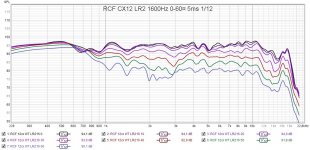
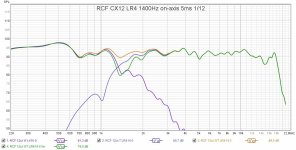
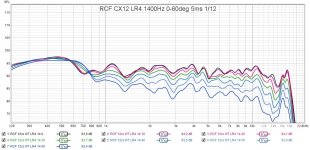
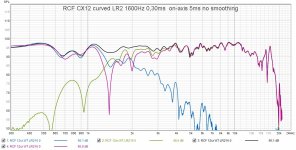
For LR4 (acoustic) xo I kept the cap, but used BW18dB at 100Hz for highpass. I also disabled 5kHz peak an set negative peak at 800Hz, to smoother horn's upper register.
With these settings, LR4 seems to give smoother response and directivity.
SLS-12 pair matching with coaxial midwoofer is easy, I can start thinking about how and where to make cabinets.




REW can't create normalized directivity or make spectrograms. And converting these for VCAD or Omnimic takes too much time. I can read these well enough. Perhaps the final speaker's outdoor measurements can be presented as normalized too. Wait until April!
These measurements are taken in a small room. Look how dirty 60deg measurements is!
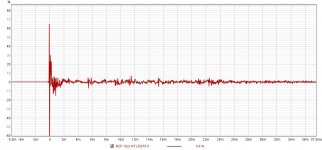
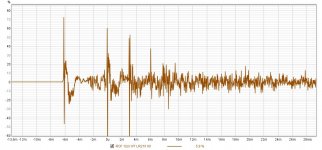
These measurements are taken in a small room. Look how dirty 60deg measurements is!


Last edited:
OK, I sacificed half of an hour of the rest of my life to learn VCAD2...
Normalized directivity polar map of RCF CX12 curved test baffle. Indoor measurement up to 60 deg, 5ms gating 1/12 smoothing. Version LR4 1400Hz

Normalized directivity polar map of RCF CX12 curved test baffle. Indoor measurement up to 60 deg, 5ms gating 1/12 smoothing. Version LR4 1400Hz
Last edited:
That half hour might turn out to be one of your best investments; beats the heck out of spending half an hour on REW trace arithmetic 🙂
Dare I ask to see a Vituix line chart? (right click in the polar map window)
Dare I ask to see a Vituix line chart? (right click in the polar map window)
right, its trivially easy with "export all measurements" if you name your rew traces with this in mind at the start. Now all you have to do is right click again and select normalized to see with DSP FIR could do for you. That seems to be far from your mind but its hard to imagine using these coax's without a substantial amount of equalization.
Haven't the drivers arrived yet?Curved test baffle has been tested and accepted!
80x1200mm and dipole, but final box can be a bit smaller. I lined the opening with cardboard, installed the coaxial driver, reset eq and xo. SLS-12 drivers haven't arrived yet.
No, short week. Posti will inform me a day before they are coming.
About those response graphics in previous posts, they all have exactly same response data (LR4 version), only presentation is different
About those response graphics in previous posts, they all have exactly same response data (LR4 version), only presentation is different
The parcel from Brno arrived today!
I put one SLS-12 in the dipole test baffle and took some measurements. I had to suppress the RCF woofer 10dB to match levels. No equalization because closed box with two parallel subwoofers will help. Now some serious thinking about how to make boxes... Size can be reduced at least 10cm in both directions.
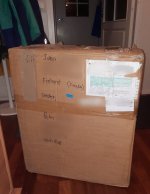
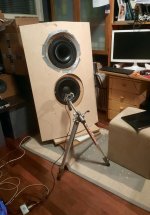
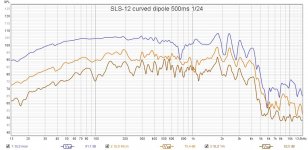
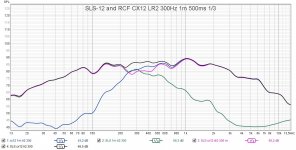
I put one SLS-12 in the dipole test baffle and took some measurements. I had to suppress the RCF woofer 10dB to match levels. No equalization because closed box with two parallel subwoofers will help. Now some serious thinking about how to make boxes... Size can be reduced at least 10cm in both directions.




No serious damages in transport, except corners of the cardboard box are rounded🙂The parcel from Brno arrived today!
I put one SLS-12 in the dipole test baffle and took some measurements. I had to suppress the RCF woofer 10dB to match levels. No equalization because closed box with two parallel subwoofers will help. Now some serious thinking about how to make boxes... Size can be reduced at least 10cm in both directions.
View attachment 1129798 View attachment 1129797
View attachment 1129801 View attachment 1129802
I eq'd responses around xo (not the 1kHz peak) and set 1ms delay for the mid. Took on-axis and negative vertical measurements to see possible effect on floor bounce... Seems like 300Hz xo gives some cancelling around 300hz which is pretty close to predicted floor bounce F, nice.
REW graphs is easier for me to read than VCAD2. VCAD atuomatically copies negative angles to positive, despite the baffle is not symmetric vertically.
The -60deg measurement has mic on the floor, which makes some changes ins response.
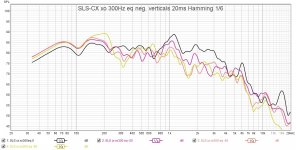
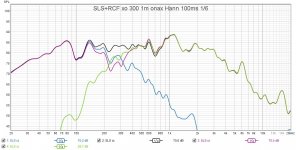
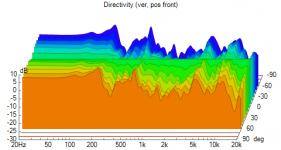
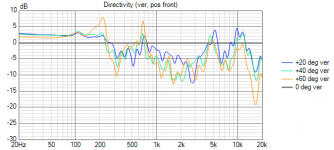
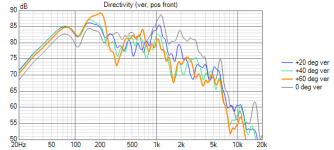
REW graphs is easier for me to read than VCAD2. VCAD atuomatically copies negative angles to positive, despite the baffle is not symmetric vertically.
The -60deg measurement has mic on the floor, which makes some changes ins response.





Last edited:
- Home
- Loudspeakers
- Multi-Way
- Big coaxial with RCF CX12N251
